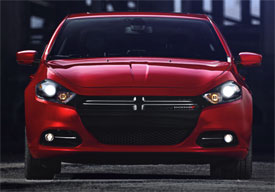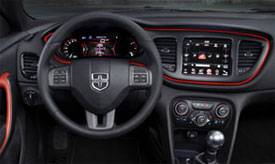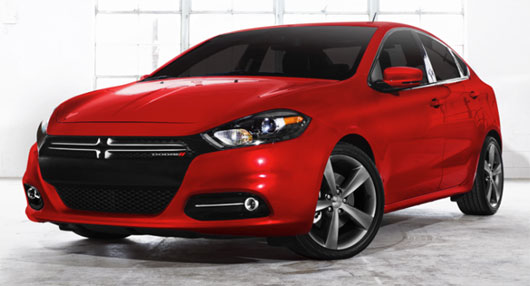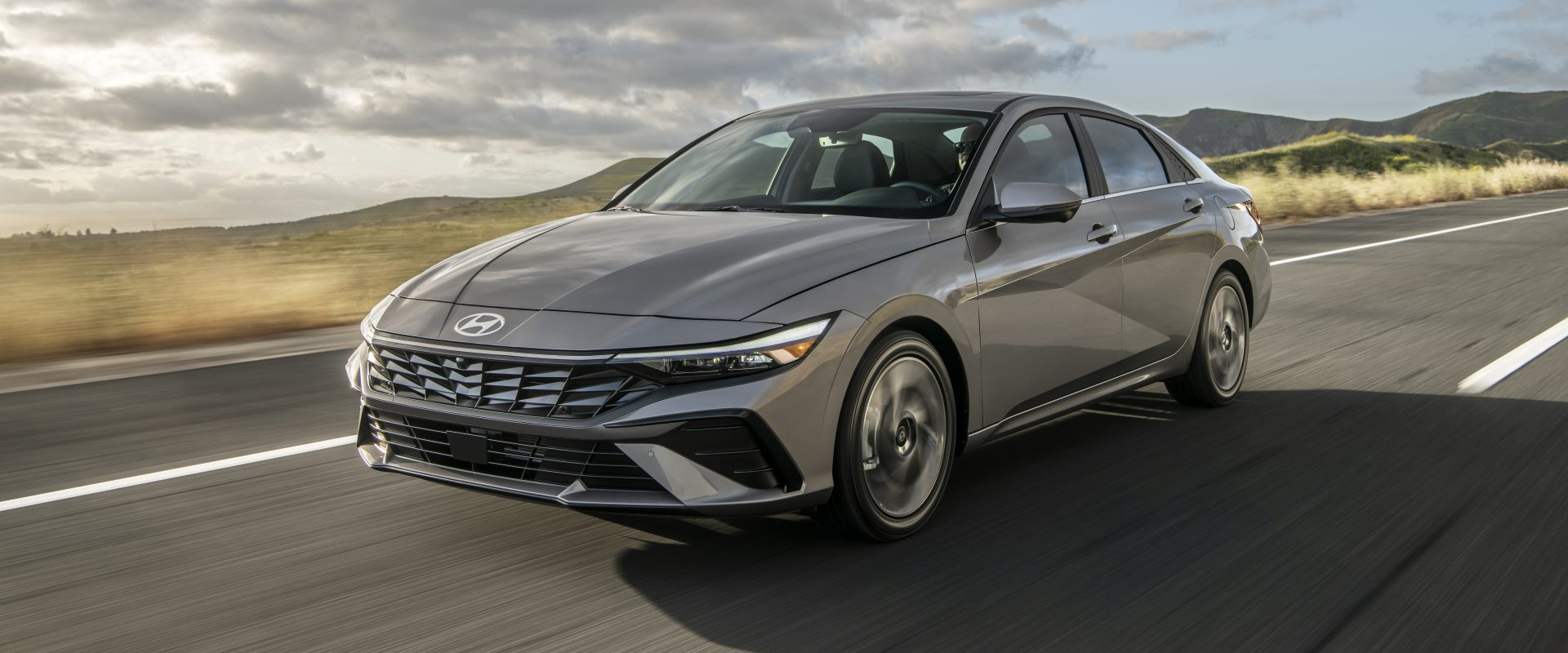2013 Dodge Dart
We always get a little nervous when we hear a classic car name making a return, especially when it’s attached to a small car. Well, the name is Dodge Dart, and it’s on Chrysler’s new Alfa Romeo-based compact. But, for those of you that don’t have fond memories of the original, the new Dart looks to be packing lots of high style and high tech features. So, let’s see if the Dart is another bulls-eye for Chrysler.
With the help of Fiat, Chrysler Group has been on a roll since emerging from bankruptcy. But, one thing that’s been missing from their line-up for nearly a decade is a viable compact sedan. Well, the 2013 Dodge Dart is a compact sedan and our first impression is that it’s way more than just viable.
Styling is certainly fresh, as the Dart joins the Hyundai Elantra as one of the most dynamic looking sedans in its segment. With its wide front end, and upsweeping side lines the Dart has a very athletic appearance, like a sprinter at the starting block. Sheet metal is taut and it indeed looks very European.
There is still the trademark Dodge crosshair grille, but it’s small and flat, with the front end more dominated by the large lower air opening. And, as is all the rage these days, active grille shutters are present, as is a full underbody aero treatment. The rear end is dominated by the Charger-inspired “racetrack” ring of LED’s, which unfortunately don’t come with all models, nor does dual exhaust. Under the Dart’s sharply creased hood, lies one of three engine choices ranging from the 1.4-liter turbo from the Fiat 500 Abarth to 2 and 2.4-liter normally aspirated I4’s.
 We’ve tried both the 1.4 and the 2-liter, and the 1.4 turbo is easily the more entertaining choice, even though it’s not as peppy here as in the much lighter Abarth. The exhaust is also muted although it still burps and pops like a classic Italian mill. The 2-liter Tigershark I4 is the standard engine on all but the R/T model and puts out the same 160-horsepower as the turbo, but far less torque at 148 pound feet.
We’ve tried both the 1.4 and the 2-liter, and the 1.4 turbo is easily the more entertaining choice, even though it’s not as peppy here as in the much lighter Abarth. The exhaust is also muted although it still burps and pops like a classic Italian mill. The 2-liter Tigershark I4 is the standard engine on all but the R/T model and puts out the same 160-horsepower as the turbo, but far less torque at 148 pound feet.
But, it was the 1.4 Turbo we took to our track. With the standard 6-speed manual, our 3,200 pound Dart managed a respectable 0-60 run of 8.2-seconds. However, it does feel faster. It takes a second for all 184 pound feet of torque to kick in, but off-the-line grunt is sufficient. Still, the ¼ mile was leisurely at 16.2-seconds and 87 miles-per-hour. A 6-speed Dual Dry Clutch automatic transmission is also available with the 1.4-turbo, while in the 2-liter you can opt for a traditional 6-speed automatic.
As the Dart is based on the Alfa Romeo Giulietta, we were expecting an entertaining trip through the cones, and we weren’t disappointed. This is the first Chrysler product with electric power steering and we found it quick and very well weighted, with a tight feel. There is a nice thick-rimmed steering wheel to play with too. When pushed hard, the Dart’s rear end lightens up just enough to have some fun and scoot through here with ease.
Brakes are a little grabby, but worked well enough to halt the Dart from 60 in a short 126-feet.
The Dart is bigger than the Giulitetta in every exterior dimension, which means plenty of room inside the great looking interior. Most materials are soft to the touch, but there are some lingering hard plastics on the doors and lower dash. There is an unusual pattern for the speaker and defrost grilles. Some like it, others thought it looked cheap. Front seating however, is top notch for a compact, and even back seat riders get deep cushioning and respectable leg room. Headroom is only an issue if you’re over 6-foot tall.
 The Dart trumps other compacts with lots of high tech features like a configurable Thin Film Transistor gauge panel, available heated steering wheel and keyless entry, a huge touch screen navigation system and an enormous glove-box, as well as under-seat storage up front. 10-airbags are standard.
The Dart trumps other compacts with lots of high tech features like a configurable Thin Film Transistor gauge panel, available heated steering wheel and keyless entry, a huge touch screen navigation system and an enormous glove-box, as well as under-seat storage up front. 10-airbags are standard.
On the road, the Dart also reacts solidly for a price-point compact car. Our 1.4 turbo has great Government Fuel Economy Ratings of 27-City and 39-Highway with the manual. We averaged a fine 28 miles-per-gallon of Premium. The 2-liter is a bit less efficient but runs on regular grade. The Energy Impact Score for the 1.4-liter is a fine 10.3-barrels of annual oil consumption with CO2 emissions of 4.6-tons. Ultimately there will be 5 trim levels of Dart, starting with the SE and a base price of $16,790.
As the first all-new car developed under Fiat leadership and Chrysler’s re-entry into the compact sedan segment, a lot is resting on the 2013 Dodge Dart’s well sculpted shoulders. And it joins the Ford Focus and Chevrolet Cruze as compelling reasons why consumers can finally consider domestic compact cars as true rivals to Civic and Elantra. The 2013 Dodge Dart does indeed hit the bull’s-eye… dead center.
Specifications
- Engine: 1.4-liter turbo
- Horsepower: 160
- Torque: 184 lb-ft.
- 0-60 mph: 8.2 seconds
- 1/4 mile: 16.2 seconds @ 87 mph
- EPA: 27 mpg city/ 39 mpg highway
- Energy Impact: 10.3 barrels oil/yr
- CO2 Emissions: 4.6 tons/yr
2024 Hyundai Elantra
Basic Transportation At Its Best…And That Is A Compliment
For those of you who write in every week bemoaning the fact that all we seem to do around here is test incredibly expensive cars and EVs that only the very well to do can afford, this one’s for you. It’s a commuter and budget friendly mainstay from Hyundai, the compact Elantra sedan. And, it has been nicely updated for 2024.
We clearly do enjoy driving high-performance machines and ultra-luxury rides around here, but like most of you, when it comes time to drive home at the end of a long workday, we do so in something much more practical and affordable, like this 2024 Hyundai Elantra sedan.
If you’re thinking the front end has gotten more aggressive, you’re right. Hyundai calls it a “Shark Nose” theme, and we’re guessing they were thinking more Great White than Hammerhead, though Megamouth shark would also apply. It helps for a low and wide look; more substantial than the typical compact. Other additions for ’24 include slimmer daytime running lights, revised stainless steel Hyundai emblem, reshaped front fenders, sport sedan-style rear diffuser with silver trim; a parametric pattern added to the C-Pillar, and new LED taillights that take up a lot more space on the highly sculpted decklid. Plus, new wheel designs in sizes ranging from 15- to 18-inches.
Standard engine in SE, SEL, and Limited grades is this naturally aspirated 2.0-liter I4 with 147 horsepower and 132 lb-ft of torque. Even with no hybrid assistance, it gets substantial Government Fuel Economy Ratings of 31 City, 40 Highway, and 34 Combined; we averaged a great 38.6 mpg of Regular.
Those high fuel economy numbers mean acceleration times are pretty high as well. It was in no particular hurry to get off the line at our test track, as after a slight jolt of power, it felt pretty sluggish going down the track, taking us a lengthy 9.4 seconds to hit 60 mph. Hyundai’s Intelligent Variable Transmission has some realistic simulated gear shifts built in, and they not only provided the feel of a true automatic, but kept engine noise from becoming overbearing. And while this 2.0-liter may not be a house-on-fire off the line, it has no problem keeping up with traffic, and feels like just the perfect amount of power for a practical and safe commuter car.
There are other engine options too. Two choices if you want to go faster, a 1.6-liter turbo with 201 horsepower in the Elantra N Line, and a 276-horsepower turbocharged 2.0-liter for the Elantra N; plus, one with even better fuel economy, a 1.6-liter hybrid with a 139 horsepower total output.
And despite some significant understeer, there was good feel through the cones of our handling course, both in steering and chassis feedback. We wouldn’t quite call it “point and shoot,” but it responded to inputs fairly quickly, with only moderate body roll. All-in-all, when it comes to performance, it doesn’t claim to bring a whole lot to the table, but does clearly overachieve with what it does bring.
And Hyundai is always overachieving when it comes to packing in features, yet has found a way of keeping things refreshingly simple with a good mix of touchscreen and manual controls. Lots of space too, both up front in the surprisingly wide front buckets, and in the rear bench with ample room for three. Updates for all Elantra interiors include softer materials on the door panels, upgraded instrumentation and additional charging ports, plus a surround view monitor and new H-Tex simulated leather for Limited trim.
Elantra pricing starts with an SE at $22,775, the SEL comes in at $24,725, Limited begins at $28,215, and the sporty N Line starts at $29,615. If you’re interested in the hybrid, base Blue starts at $27,400 with Limited at $30,600.
Some might say there’s not a whole lot that’s earth shaking about the 2024 Hyundai Elantra, but that’s mostly why we like it so much. When it comes to just delivering good, basic transportation with a high dose of unexpected amenities, Hyundai delivers once again.
Specifications
- Engine: 2.0-liter I4
- Horsepower: 147
- 0-60 mph: 9.4 seconds
- 60-0 Braking: 111 ft (avg)
- MW Fuel Economy: 38.6 MPG (Regular)
- Transmission: IVT
- Torque: 132 lb-ft
- 1/4 Mile: N/A (Track Maintenance)
- EPA: 31 City / 40 Highway / 34 Combined







